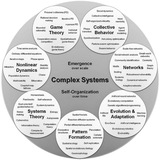📄 Universality of the SIS prevalence in networks
Piet Van Mieghem
https://arxiv.org/pdf/1612.01386v1
📌 ABSTRACT
Epidemic models are increasingly used in real-world networks to understand diffusion phenomena (such as the spread of diseases, emotions, innovations, failures) or the transport of information (such as news, memes in social on-line networks). A new analysis of the prevalence, the expected number of infected nodes in a network, is presented and physically interpreted. The analysis method is based on spectral decomposition and leads to a universal, analytic curve, that can bound the time-varying prevalence in any finite time interval. Moreover, that universal curve also applies to various types of Susceptible-Infected-Susceptible (SIS) (and Susceptible-Infected-Removed (SIR)) infection processes, with both homogenous and heterogeneous infection characteristics (curing and infection rates), in temporal and even disconnected graphs and in SIS processes with and without self-infections. The accuracy of the universal curve is comparable to that of well-established mean-field approximations.
Subjects: #Physics and #Society (physics.soc-ph); #Social and #Information #Networks (cs.SI); #Populations and #Evolution (q-bio.PE)
Piet Van Mieghem
https://arxiv.org/pdf/1612.01386v1
📌 ABSTRACT
Epidemic models are increasingly used in real-world networks to understand diffusion phenomena (such as the spread of diseases, emotions, innovations, failures) or the transport of information (such as news, memes in social on-line networks). A new analysis of the prevalence, the expected number of infected nodes in a network, is presented and physically interpreted. The analysis method is based on spectral decomposition and leads to a universal, analytic curve, that can bound the time-varying prevalence in any finite time interval. Moreover, that universal curve also applies to various types of Susceptible-Infected-Susceptible (SIS) (and Susceptible-Infected-Removed (SIR)) infection processes, with both homogenous and heterogeneous infection characteristics (curing and infection rates), in temporal and even disconnected graphs and in SIS processes with and without self-infections. The accuracy of the universal curve is comparable to that of well-established mean-field approximations.
Subjects: #Physics and #Society (physics.soc-ph); #Social and #Information #Networks (cs.SI); #Populations and #Evolution (q-bio.PE)
📄 Statistical physics of vaccination
Zhen Wang, Chris T. Bauch, Samit Bhattacharyya, Alberto d'Onofrio, Piero Manfredi, Matjaz Perc,Nicola Perra, Marcel Salathé, Dawei Zhao
https://arxiv.org/pdf/1608.09010v3
📌 ABSTRACT
Historically, infectious diseases caused considerable damage to human societies, and they continue to do so today. To help reduce their impact, mathematical models of disease transmission have been studied to help understand disease dynamics and inform prevention strategies. Vaccination - one of the most important preventive measures of modern times - is of great interest both theoretically and empirically. And in contrast to traditional approaches, recent research increasingly explores the pivotal implications of individual behavior and heterogeneous contact patterns in populations. Our report reviews the developmental arc of theoretical epidemiology with emphasis on vaccination, as it led from classical models assuming homogeneously mixing (mean-field) populations and ignoring human behavior, to recent models that account for behavioral feedback and/or population spatial/social structure. Many of the methods used originated in statistical physics, such as lattice and network models, and their associated analytical frameworks. Similarly, the feedback loop between vaccinating behavior and disease propagation forms a coupled nonlinear system with analogs in physics. We also review the new paradigm of digital epidemiology, wherein sources of digital data such as online social media are mined for high-resolution information on epidemiologically relevant individual behavior. Armed with the tools and concepts of statistical physics, and further assisted by new sources of digital data, models that capture nonlinear interactions between behavior and disease dynamics offer a novel way of modeling real-world phenomena, and can help improve health outcomes. We conclude the review by discussing open problems in the field and promising directions for future research.
Comments:150 pages, 42 figures; published in Physics ReportsSubjects:Physics and #Society (physics.soc-ph); #Statistical_Mechanics (cond-mat.stat-mech); Social and Information #Networks (cs.SI); #Populations and #Evolution (q-bio.PE); Applications (stat.AP)
Zhen Wang, Chris T. Bauch, Samit Bhattacharyya, Alberto d'Onofrio, Piero Manfredi, Matjaz Perc,Nicola Perra, Marcel Salathé, Dawei Zhao
https://arxiv.org/pdf/1608.09010v3
📌 ABSTRACT
Historically, infectious diseases caused considerable damage to human societies, and they continue to do so today. To help reduce their impact, mathematical models of disease transmission have been studied to help understand disease dynamics and inform prevention strategies. Vaccination - one of the most important preventive measures of modern times - is of great interest both theoretically and empirically. And in contrast to traditional approaches, recent research increasingly explores the pivotal implications of individual behavior and heterogeneous contact patterns in populations. Our report reviews the developmental arc of theoretical epidemiology with emphasis on vaccination, as it led from classical models assuming homogeneously mixing (mean-field) populations and ignoring human behavior, to recent models that account for behavioral feedback and/or population spatial/social structure. Many of the methods used originated in statistical physics, such as lattice and network models, and their associated analytical frameworks. Similarly, the feedback loop between vaccinating behavior and disease propagation forms a coupled nonlinear system with analogs in physics. We also review the new paradigm of digital epidemiology, wherein sources of digital data such as online social media are mined for high-resolution information on epidemiologically relevant individual behavior. Armed with the tools and concepts of statistical physics, and further assisted by new sources of digital data, models that capture nonlinear interactions between behavior and disease dynamics offer a novel way of modeling real-world phenomena, and can help improve health outcomes. We conclude the review by discussing open problems in the field and promising directions for future research.
Comments:150 pages, 42 figures; published in Physics ReportsSubjects:Physics and #Society (physics.soc-ph); #Statistical_Mechanics (cond-mat.stat-mech); Social and Information #Networks (cs.SI); #Populations and #Evolution (q-bio.PE); Applications (stat.AP)
How do #WritingSystems change over time — and what forces drive that #evolution?
Watch our 3-minute explainer #animation on new computational analyses of #WrittenLanguage
https://t.co/libdz1jlTG
#cognition #linguistics #culturalevolution
Watch our 3-minute explainer #animation on new computational analyses of #WrittenLanguage
https://t.co/libdz1jlTG
#cognition #linguistics #culturalevolution
YouTube
What Determines The Complexity of Writing Systems?
Read the paper, "Graphic complexity in writing systems" by Helena Miton and Olivier Morin:
https://www.sciencedirect.com/science/article/pii/S0010027721001906
Read the authors' Twitter threads on this paper:
https://twitter.com/HelenaMiton/status/1397221515708481536…
https://www.sciencedirect.com/science/article/pii/S0010027721001906
Read the authors' Twitter threads on this paper:
https://twitter.com/HelenaMiton/status/1397221515708481536…
